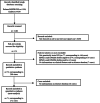Natural history of Lafora disease: a prognostic systematic review and individual participant data meta-analysis
- PMID: 34399803
- PMCID: PMC8365996
- DOI: 10.1186/s13023-021-01989-w
Natural history of Lafora disease: a prognostic systematic review and individual participant data meta-analysis
Abstract
Background: Lafora disease (LD) is a rare fatal autosomal recessive form of progressive myoclonus epilepsy. It affects previously healthy children or adolescents, causing pharmacoresistant epilepsy, myoclonus and severe psychomotor deterioration. This work aims to describe the clinical course of LD and identify predictors of outcome by means of a prognostic systematic review with individual participant data meta-analysis.
Methods: A search was conducted on MEDLINE and Embase with no restrictions on publication date. Only studies reporting genetically confirmed LD cases were included. Kaplan-Meier estimate was used to assess probability of death and loss of autonomy. Univariable and multivariable Cox regression models with mixed effects (clustered survival data) were performed to evaluate prognostic factors.
Results: Seventy-three papers describing 298 genetically confirmed LD cases were selected. Mean age at disease onset was 13.4 years (SD 3.7), with 9.1% aged ≥ 18 years. Overall survival rates in 272 cases were 93% [95% CI 89-96] at 5 years, 62% [95% CI 54-69] at 10 years and 57% [95% CI 49-65] at 15 years. Median survival time was 11 years. The probability of loss of autonomy in 110 cases was 45% [95% CI 36-55] at 5 years, 75% [95% CI 66-84] at 10 years, and 83% [95% CI 74-90] at 15 years. Median loss of autonomy time was 6 years. Asian origin and age at onset < 18 years emerged as negative prognostic factors, while type of mutated gene and symptoms at onset were not related to survival or disability.
Conclusions: This study documented that half of patients survived at least 11 years. The notion of actual survival rate and prognostic factors is crucial to design studies on the effectiveness of upcoming new disease-modifying therapies.
© 2021. The Author(s).
Conflict of interest statement
Authors declare no competing interests.
Figures



References
-
- La GP. Maladie de Lafora (EPM2) Rev Neurol. 2007;163(1):47–53. - PubMed
Publication types
MeSH terms
LinkOut - more resources
Full Text Sources
Other Literature Sources
Research Materials

